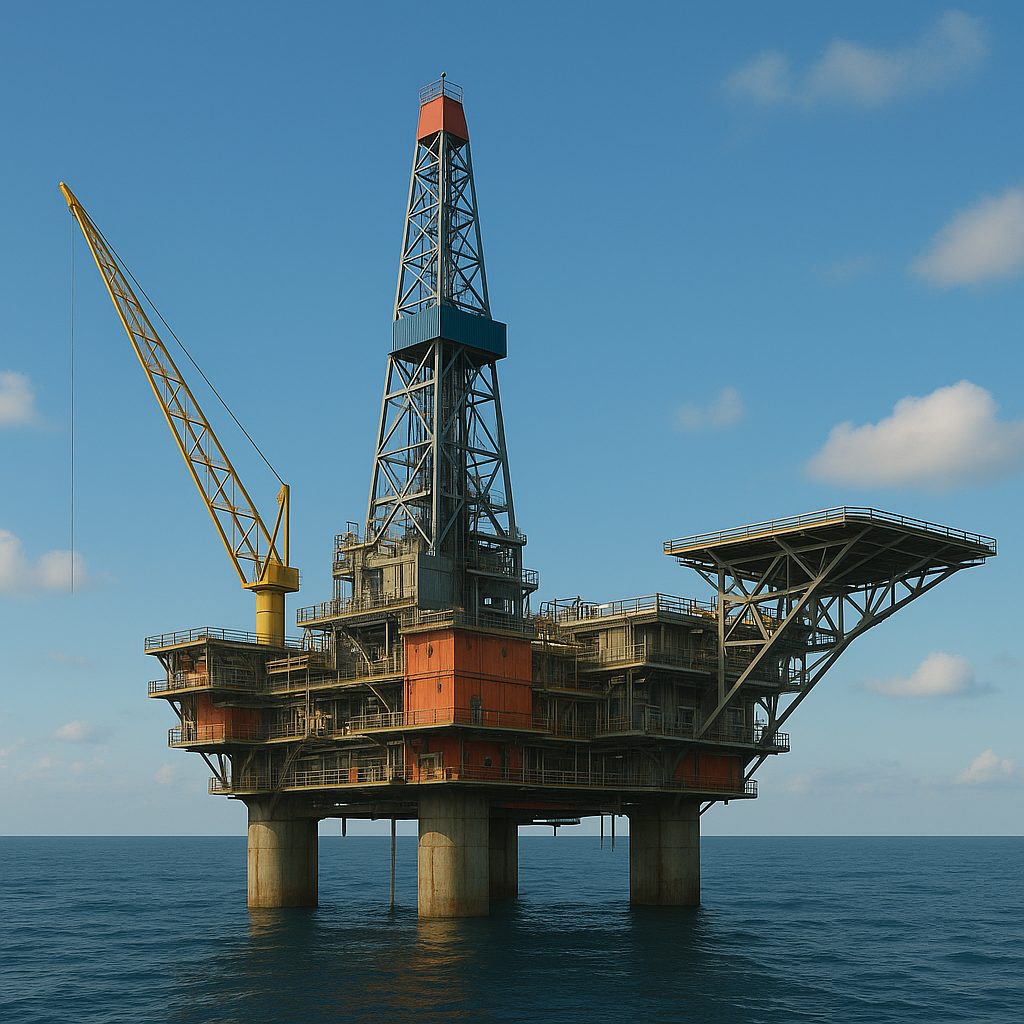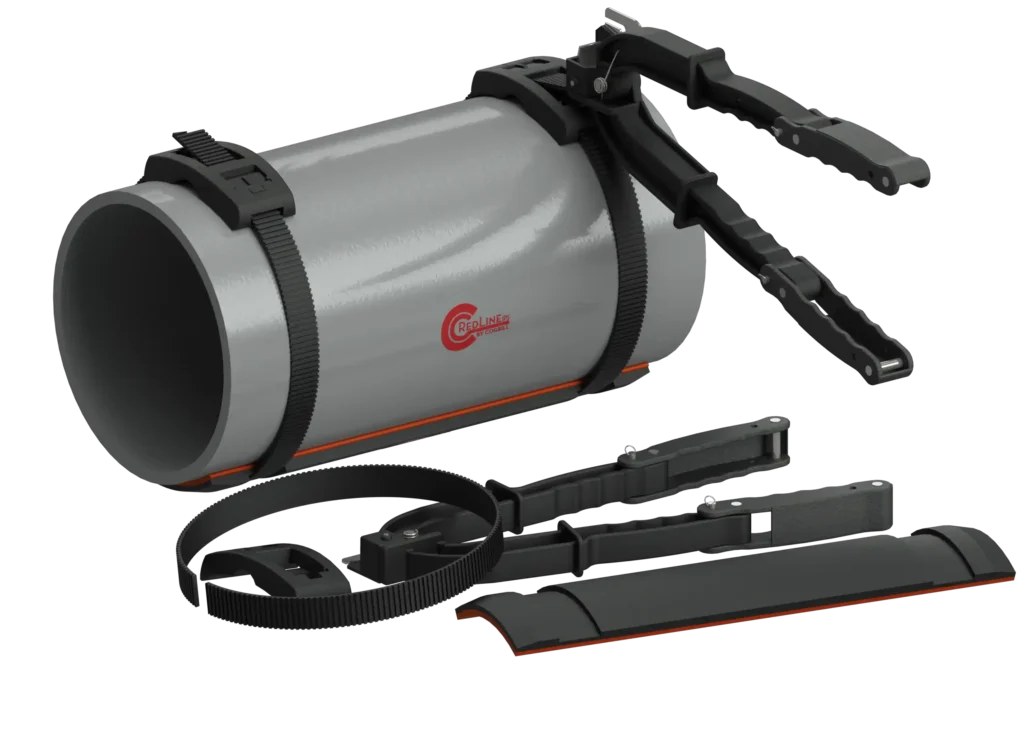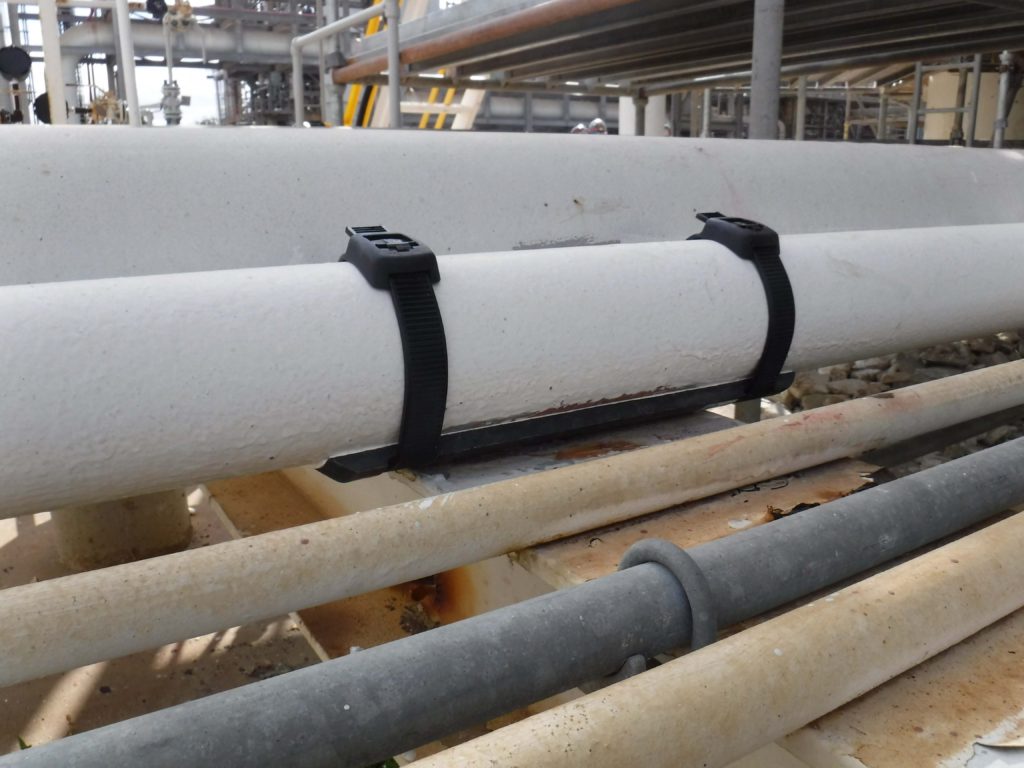Abstract:
Small details cause big problems offshore. One of the most common trouble spots is the narrow contact region where a pipe sits on its metallic support. Salt spray, frequent washdowns, condensation, and constant micro-movement allow moisture to linger in that shaded gap. Over time, this leads to Corrosion Under Pipe Supports (CUPS), extra noise and vibration, and, in the worst cases, leaks that can escalate into fires or explosions.
This article explains what offshore platforms and FPSOs are, why CUPS forms at supports, how the RedLineIPS SmartPad System works, and how its benefits apply to both fixed and floating facilities.
Offshore platforms vs. FPSOs
Offshore platforms are stationary structures anchored to the seabed. Examples include steel jackets and gravity-based structures. They hold process equipment above the ocean and are exposed to wind-driven salt, rain, and frequent firewater testing. Piping is packed tightly in racks, so supports are everywhere.
FPSOs (Floating Production, Storage and Offloading units) are ship-shaped facilities that produce hydrocarbons and store them until a shuttle tanker offloads the cargo. FPSOs live with constant motion—heave, roll, and pitch—and wide temperature swings across decks. This motion keeps tiny gaps “alive,” inviting moisture and deposits to remain under pipe supports. In short, an FPSO is a special case of an offshore production platform with more motion and more wetting at support interfaces.
What is CUPS?
CUPS, corrosion that forms at the pipe support contact, develops when salty moisture, trapped deposits, and microbial biofilms persist in that crevice. The electrolyte film lingers, oxygen becomes uneven across the contact area (differential aeration), and even small coating nicks evolve into hidden attack. Top corrosion modes at supports are:
- Crevice corrosion: Stagnant brine inside a tight gap depletes oxygen. The crevice becomes acidic and chloride-rich, so under-film attack accelerates out of sight.
- Under-deposit corrosion (UDC): Deposits like salt, silt, or rust scale trap electrolyte and create differential aeration cells that pit the steel beneath the “dirt cap.”
- Microbiologically influenced corrosion (MIC): Biofilms change local chemistry (e.g., sulfides, pH). The result is irregular, aggressive pitting that is hard to predict.
- Chloride pitting: Chlorides find small coating flaws and drive deep pits with little external warning.
- Galvanic & differential-aeration couples: A metal-to-metal path (pipe on steel support) or oxygen-poor zones can make the pipe anodic, speeding loss at the pipe/support contact region.

Why CUPS matters
- Safety: A small through-wall pit at a support can atomize hydrocarbons. With an ignition source, that can become a jet fire or vapor-cloud explosion.
- Operations and cost: Unplanned shutdowns, emergency permits, scaffolding at height, and cleanup follow. One hidden crevice can create very public consequences.
- Environmental impact: Leaks can release hydrocarbons or chemicals to deck, drains, or trigger spill response, reporting, and remediation.
- Regulatory and legal exposure: Corrosion-related failures draw regulator attention, fines, consent decrees, and potential litigation.
- Reliability and production: Forced outages, rate reductions, and deferred cargo/offloads reduce availability and revenue.
- Inspection burden and risk: More NDT at height and in congested racks increases exposure hours and HSE risk for inspectors.
- Insurance and financing: Incidents can drive premium hikes, deductibles, and tougher covenants or ESG (Environmental, Social, and Governance) scrutiny.
- Asset life and valuation: Accelerated wall loss undermines remaining life estimates, inflates AIMS (Asset Integrity Management System) budgets, and depresses asset value at sale or transfer.
What is the SmartPad System?
The SmartPad System replaces steel-on-steel contact with a sealed, non-metallic, and reopenable interface. It installs cold on live lines, without welding, drilling, or epoxy. It opens quickly so teams can see the hotspot directly and then reseal it in minutes.

- Composite (FRP) SmartPad (contoured saddle)
- What it does: Spreads load so there is no point or line loading. The smooth, radiused contact protects intact coatings. Recessed band grooves prevent the bands from “walking.” Sloped edges help the pad re-center after large thermal movement.
- How it’s built: Laminated continuous-strand mat in vinyl-ester resin, purpose-built for pipe support (not repurposed duct). Dielectric and UV-resistant.
- Properties: Fire-retardant formulation. Custom OD/length/thickness options.
- Hydroseal Gasket (bonded, closed-cell seal & damper)
- What it does: Compresses into the paint texture to create a watertight, NEMA-4-like moisture seal at the pipe/pad interface. Blocks capillary wicking. Damps micro-motion to reduce rattle and structure-borne noise. Eliminates installer-sensitive epoxy perimeter seals and the voids they can leave behind.
- Properties: Closed-cell construction; variable thicknesses available.
- SmartBand & Buckle (composite clamping with stable preload)
- What it does: All-composite bands and square-tooth, non-backdrivable buckles keep durable preload without metal contact. Bands sit in recessed grooves to resist migration. For inspection, bands are cut and replaced, allowing fast lift–look–re-band inspection process.
- Properties: Long-strand architecture for toughness; dielectric and UV-resistant.
- SmartTool (Sturdy & ergonomic)
- What it does: Applies repeatable band tension so gasket compression is consistent across crews and shifts, with minimal force. Built-in tail trimming keeps installs clean.
- Options: Manual, mechanical (precise setpoints), and pneumatic (fast campaigns for mass installations).
System Benefits for FPSOs and offshore platforms
1. Corrosion control at the pipe/support interface
- Sealed pipe/pad interface with NEMA-4-like watertight seal when compressed. Excludes brine films, even on windward and splash-exposed faces.
Mitigates: crevice, UDC, MIC, chloride pitting. - All-composite, dielectric load path, preventing metal-to-metal contact between pipe and supporting structure. FRP saddle + closed-cell gasket + composite bands break electrical continuity to support steel.
Mitigates: galvanic and differential-aeration couples. - Non-wicking, closed-cell gasket blocks capillary paths and conforms to imperfect or aged coatings.
Mitigates: crevice, UDC, MIC, pitting. - Interface damping that cushions micro-motion from hull movement and thermal growth.
Mitigates: fretting-assisted corrosion and debris/brine nests.
2. Built for offshore exposure patterns
- Works on windward faces, washdown/splash zones, and sweating cold services, keeping the interface dry during firewater tests and condensation cycles.
- UV-stable FRP and gasket options help preserve the seal in open-deck sunlight.
- Broad service envelope (material-dependent) that allows one approach across chilled, ambient, and hot duties, ideal for mixed-service topsides on FPSOs and fixed offshore platforms.
3. Mechanical integrity & coating care
- Contoured saddle prevents point/line loading and protects sound coatings.
- Recessed strap grooves (anti-walk) keep clamp force on the saddle, not the paint, and prevent pad drop-off.
- Durable preload (square-tooth buckle + long-strand band) resists loosening through vibration and thermal cycling.
4. Installation, inspection & operations
- Cold-work installs on live lines; epoxy-free: No welding or drilling, no cure windows, minimal clearance needed (often ~1–2 in).
- Preset tensioning (SmartTool): Consistent compression → consistent sealing, simpler QA/QC.
- Rapid “lift–look–re-band” in minutes: True direct visual at the hotspot—even in tight racks and at height—reduces reliance on expensive, indirect non-destructive testing (NDT) such as EMAT, radiography, and ultrasonic testing, and catches issues early.

5. Safety & EHS
- Fewer hot-work and solvent tasks: Simpler permits and lower fire/VOC exposure.
- Shorter tasks at height; fewer confined-space NDT trips: Lower exposure hours with more frequent, higher-quality inspections.
6. Integration & deployment
- Retrofit-friendly: Drops into existing steelwork. Start with high-risk circuits (sweating cold lines, washdown paths, windward racks) and expand by risk-based inspection (RBI)
- Newbuild-ready: Specify in support standards/isometrics so interfaces are sealed and dielectric at commissioning, no hot work and no adhesive curing.
- CP/earthing compatibility: Verify isolation with a quick resistance check after install.
7. Materials & assurance
- Proven building blocks: Industrial FRP laminates, closed-cell elastomers, and composite banding used offshore for decades—integrated into a sealed, dielectric, reopenable interface.
- Gasket chemistries: EPDM, silicone, and PTFE-faced options to match media and temperature and reduce stick-slip.
8. Total Cost of Ownership (TCO)
- Install time in minutes per support (vs. hours for welded/epoxied options) → fewer permits, no cure windows, less waiting on access/scaffolding.
- Lower skill mix needed: No coded welders or adhesive specialists; short tool training.
- Reduced inspection burden: Many hotspot checks become quick visuals; fewer UT/EMAT/RT spot checks at height or in tight racks.
- Minimal coating touch-up: No weld spatter, drilling, or adhesive cleanup; radiused contact and band-in-groove protect paint.
- Reusability: Reuse the saddle and buckles; replace low-cost band stock when re-banding.
- Programmatic OPEX reduction: Faster campaigns, earlier detection, and fewer emergency repairs, especially compelling on motion-rich FPSOs.
Conclusion
CUPS is predictable and preventable. By replacing steel-on-steel contact with a sealed, dielectric, and reopenable interface, the RedLineIPS SmartPad System targets the exact conditions that drive crevice, UDC, MIC, chloride pitting, and galvanic attack at supports. The result is lower risk of leaks and fires, less noise and vibration, better coating longevity, and a simpler inspection workflow across FPSOs and fixed offshore platforms alike.
FAQ
What is CUPS in offshore piping?
CUPS is corrosion that forms at the pipe/support contact when brine and deposits linger in the shaded gap. It progresses out of sight and can lead to leaks, fires, and unplanned downtime.
How does SmartPad stop CUPS?
It seals the gap with a bonded, closed-cell watertight gasket that is designed to prevent moisture ingress between pipe and support, breaks the metal-to-metal path with its non-metallic components, and damps micro-movement so fretting and debris nests do not develop.
Is SmartPad suitable for FPSOs and offshore platforms?
Yes. The sealed, non-metallic interface handles constant motion and wetting. Rapid lift–look–re-band inspections fit offshore platforms in general and FPSOs in particular, reducing the need for maintenance at height and in congested racks.
Do I need hot work or epoxy?
No. SmartPad installs cold on live lines and does not require welding, drilling, or epoxy of any kind.
What about inspection and maintenance?
Bands are cut to open the interface, the surface is wiped and photographed, and fresh bands are applied, usually in minutes per support.

